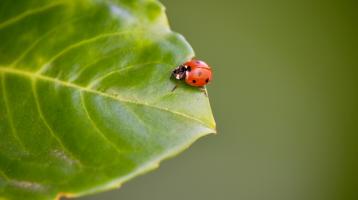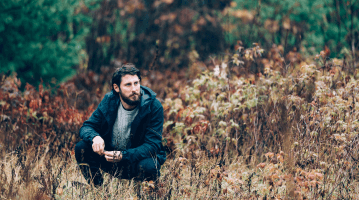What is biodiversity?
Raising awareness, preserving, exploring and sharing – biodiversity is what drives us, inspires us, compels us. For over 25 years now, Klorane Botanical Foundation has been committed to biodiversity.
Biodiversity is the “whole” that encompasses and surrounds us. It’s the animals and plants on which we have an undeniable impact, and on which our very existence depends. We’re only ever privileged to a quick glimpse of its richness, even if we’re constantly pushing forward the limits of our understanding. But the threats to biodiversity are well documented.
Definition of biodiversity: more than a word, a commitment
Biodiversity is a contraction of the words biology and diversity. But combining these two terms has given rise to a much broader concept than simply adding them together. The term was coined in 1986 at a conference in Washington, when American scientist Walter G. Rosen suggested the event be called the National Forum on BioDiversity. But his suggestion would have ramifications far beyond a simple name change and would leave its mark for decades to come.
The Man and the Biosphere Programme in 1971
When we talk about “biological diversity”, we mean an inventory of every living organism within a given area. From the Greek βίο, meaning “life”, the expression encompasses all forms of life, from invisible bacteria to giant mammals, plus all the plants, fungi and, of course, humans. Although scientific interest in the diversity of living organisms really began in the 18th century, it wasn’t until the 1960s that things really started to take off. Awareness of the ecological crisis unfolding before our very eyes began to spread beyond scientific circles and into the public realm. By 1968, UNESCO had held the first Biosphere Conference in Paris and, in 1971, the Man and the Biosphere Programme was officially launched. It was at that time that people began talking about biological diversity as a way of highlighting the immense wealth of species and the complexity of their interactions. But the expression would remain merely an observation for a while, the fact there are many living species on Earth.
The Rio Earth Summit in 1992
The turn of the 1980s saw the arrival of a new branch of science, conservation biology, which dealt with the topics and issues raised by the environmental movements head on. Walter G. Rosen’s proposal about the term “biodiversity” became part of the new approach. He believed we mustn’t see nature simply as an inventory, but rather a set of interdependent phenomena that are under threat and must be protected. As a result, biodiversity became a call to action, recognition of a richness that needs to be preserved and an incentive not to sit back and simply list disappearances year after year. The term was officially adopted at the first Earth Summit held in Rio in 1992, which recognised – for the very first time – the importance of conserving biodiversity for all of humanity.
Biological diversity is essential to life on Earth
Biodiversity is a rallying cry, a call to action, where individuals take their rightful place, not as observers, but as stakeholders. Biodiversity refers to all living things on Earth, their interactions within complex ecosystems, as well as the need to preserve the conditions needed for all these organisms to live on the planet.
The countless species that make up the living world don’t just co-exist in silence, they interact with one another in five different ways:
- competition, as species fight for the same resources, including habitats, food, etc.;
- parasitism, where one species benefits from another while being harmful or even lethal to it;
- commensalism, where one species benefits from another without the latter being harmed;
- mutualism, where benefits are reciprocal;
- symbiosis, where two species can’t live without each other.
These interactions form what we call ecosystems, coherent groups within which species coexist. These are fragile relationships, make no mistake, built up over millions of years and constantly evolving, which must be protected at all costs. Otherwise, these highly complex chains on which we depend to survive may be damaged beyond repair. Bees and pollinating insects are a common example: bees live in mutualism with flowers. They feed off the flowers and, in return, help the flowers pollinate as they fly from flower to flower, an essential stage in their reproduction. No bees means no flowers. No flowers means no insects. No insects means no crops. No crops means no food.
Biological diversity is essential to life on Earth. Every living thing has its place and its role (yes, even mosquitos!), and we all depend on each other to function properly. Put simply, preserving biodiversity means preserving the conditions for life on Earth. The term has become inseparable from the threats to living things and our responsibility to do something to preserve it.
What are the different levels of biodiversity?
Biodiversity can be broken down into three levels:
- The diversity of living environments, known as ecosystems. From the most obvious, like oceans, coral reefs, meadows, forests and high mountains, to the most microscopic, like the cells in our bodies that harbour parasites and bacteria, as well as the most unexpected, like strips of wild grass between two paving stones, and the most fleeting, such as a pond that only forms after heavy rain;
- The diversity of species that occupy and form these environments, which all interact with one another and their ecosystems;
- The genetic diversity of individuals within the same species. You and your nextdoor neighbour biologically belong to the same species, but you probably don’t share the same genetic makeup (at least in principle, but that’s none of our business...!).
What are the threats to biodiversity?
Thanks to the work carried out over the last thirty years by the various bodies responsible for biodiversity around the world, we have come to a conclusion that is as certain as it is chilling: biodiversity is in freefall. That living things appear and disappear is the law of evolution? Let's not blame everything on Darwin.
While some species have indeed evolved or disappeared over the billions of years that life has existed on Earth, biodiversity loss has never been as massive and meteoric as it has been over the last two centuries – 10 to 1,000 times faster than the natural rate, leading to the idea of a sixth mass extinction event, capable of irreparably damaging many ecosystems. What has changed in the last 200 years? Human pressures are the first and only direct cause of this meteoric collapse in biodiversity.
France’s National Biodiversity Agency lists five major human factors that affect biodiversity:
- The conversion of natural environments into artificial ones is the main cause of the destruction and fragmentation of ecosystems. Clearing forests to make way for roads, damming watercourses, concreting over wetlands to make way for car parks... Man is disrupting the free movement and reproduction cycles of many species.
- Air, soil, water, light and sound pollution affect every aspect of the environment, making habitats uninhabitable and violently disrupting the life cycle of species to the point where they can no longer survive and have no room to evolve or change their habitats. For example, the noise generated by constant fishing boat traffic and offshore industries disrupts the sonar function of cetaceans, which – now disorientated – run aground on beaches or swim up freshwater rivers where they die of malnutrition.
- Overexploitation of resources seriously compromises how ecosystems function and their ability to regenerate. This is particularly true of the fishing and forestry industries, which – in the absence of effective regulation and sustainable quotas – jeopardise the ability of fish stocks and forests to regenerate. It’s also often the consequence of massive deforestation, where forests and all their biodiversity are replaced by intensive monocultures, such as soya or palm oil.
- Caused by the concentration of greenhouse gases in the atmosphere as a result of human activity, climate change is profoundly altering the life cycles of all living things. It also impacts the geographical distribution of species and therefore the food chain. And this disruption is global. Higher temperatures, wildfires, storms, rising sea levels, floods... we tend to see climate change through the prism of the damage it does to our lives as humans, but these events have an impact on all ecosystems and all living things.
- The intentional or unintentional introduction of invasive exotic species by humans has led to the disappearance of many native species in the ecosystems they take over, or “parasitise”. It’s not just the Louisiana crayfish, the Asian hornet, the coypu or the red-eared slider that we know about, but a large number of terrestrial and aquatic plants, like pampas grass and primrose willow, are displaced from their places of origin every year because of human activity.

Biodiversity of the future

Why has biodiversity varied over time?

Why is biodiversity under threat?
